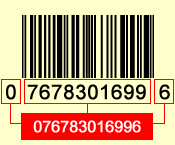To help you create an accurate listing, enter one of these identification numbers, if available. This will help categorize your item so that buyers can find it easily.
UPC (Universal Product Code):
A unique 12-digit number available on your item or product packaging near the bar code. Make sure to type all the numbers, without hyphens.

ISBN (International Standard Book Number):
A unique 10- or 13-digit number available on the back of your book near the bar code. Make sure to type all the numbers, without hyphens.

VIN (Vehicle Identification Number):
VIN location varies. It's typically found on your vehicle registration card, driver's side dashboard, driver's side door jamb, or automobile insurance card.

Why including your VIN is important when listing a vehicle:
Since 1981, the US government requires that all over-the-road vehicles sold in the US contain a 17-character VIN.
The VIN is an extremely important piece of information for a potential buyer. It can be used to consult public sources such as AutoCheck about the history of the vehicle (such as flood or collision damage). In addition, eBay Motors Vehicle Protection Programs require a VIN for vehicles newer than 1981. Failure to provide a VIN might suggest to the buyer that the car has problems that the seller is trying to hide. If you don't provide a VIN in your listing, you should explain why in your description.
Your VIN may not be accepted if:
You typed the VIN incorrectly. For example, a zero (0) may look like the uppercase letter "O." Be sure to double-check your entry.
You left out a number or letter. A standard VIN has 17 characters.
Your vehicle is older than the model year of 1981, and doesn't have a standard VIN.
Your vehicle was manufactured outside the US and wasn't intended for use in the US.
Your vehicle is a "kit car" or a limited production vehicle, and doesn't have a standard VIN.